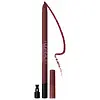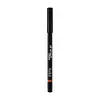What's inside
What's inside
 Key Ingredients
Key Ingredients

 Benefits
Benefits

 Concerns
Concerns

 Ingredients Side-by-side
Ingredients Side-by-side

Dimethicone
EmollientSynthetic Wax
AbrasiveTrimethylsiloxysilicate
EmollientPhenylpropyldimethylsiloxysilicate
EmollientKaolin
AbrasiveMica
Cosmetic ColorantDiisostearyl Malate
EmollientStearoxymethicone/Dimethicone Copolymer
EmollientCalcium Silicate
AbsorbentSynthetic Fluorphlogopite
Dicalcium Phosphate
AbrasiveGlycine Soja Seed Extract
Skin ConditioningGlycyrrhiza Glabra Leaf Extract
Skin ConditioningDictyopteris Polypodioides Extract
EmollientPhospholipids
Skin ConditioningCopernicia Cerifera Wax
Caprylic/Capric Triglyceride
MaskingPolyhydroxystearic Acid
EmulsifyingMicrocrystalline Wax
Emulsion StabilisingDisteardimonium Hectorite
StabilisingIsostearic Acid
CleansingPentaerythrityl Tetra-Di-T-Butyl Hydroxyhydrocinnamate
AntioxidantPropylene Carbonate
SolventLecithin
EmollientPolyglyceryl-3 Polyricinoleate
EmulsifyingSilica
AbrasiveCI 19140
Cosmetic ColorantCI 77891
Cosmetic ColorantCI 42090
Cosmetic ColorantCI 15850
Cosmetic ColorantIron Oxides
CI 77742
Cosmetic ColorantCI 15985
Cosmetic ColorantDimethicone, Synthetic Wax, Trimethylsiloxysilicate, Phenylpropyldimethylsiloxysilicate, Kaolin, Mica, Diisostearyl Malate, Stearoxymethicone/Dimethicone Copolymer, Calcium Silicate, Synthetic Fluorphlogopite, Dicalcium Phosphate, Glycine Soja Seed Extract, Glycyrrhiza Glabra Leaf Extract, Dictyopteris Polypodioides Extract, Phospholipids, Copernicia Cerifera Wax, Caprylic/Capric Triglyceride, Polyhydroxystearic Acid, Microcrystalline Wax, Disteardimonium Hectorite, Isostearic Acid, Pentaerythrityl Tetra-Di-T-Butyl Hydroxyhydrocinnamate, Propylene Carbonate, Lecithin, Polyglyceryl-3 Polyricinoleate, Silica, CI 19140, CI 77891, CI 42090, CI 15850, Iron Oxides, CI 77742, CI 15985
 Reviews
Reviews

Ingredients Explained
These ingredients are found in both products.
Ingredients higher up in an ingredient list are typically present in a larger amount.
This ingredient is an emollient, solvent, and texture enhancer. It is considered a skin-softener by helping the skin prevent moisture loss.
It helps thicken a product's formula and makes it easier to spread by dissolving clumping compounds.
Caprylic Triglyceride is made by combining glycerin with coconut oil, forming a clear liquid.
While there is an assumption Caprylic Triglyceride can clog pores due to it being derived from coconut oil, there is no research supporting this.
Learn more about Caprylic/Capric TriglycerideCI 19140 is also known as Tartrazine. Tartrazine is a synthetic dye used in cosmetics, foods, and medicine to add a yellow color.
Tartrazine is created from petroleum and is water-soluble.
Some people may experience allergies from this dye, especially asthmatics and those with an aspirin intolerance.
Learn more about CI 19140Ci 77891 is a white pigment from Titanium dioxide. It is naturally found in minerals such as rutile and ilmenite.
It's main function is to add a white color to cosmetics. It can also be mixed with other colors to create different shades.
Ci 77891 is commonly found in sunscreens due to its ability to block UV rays.
Learn more about CI 77891Dimethicone is a type of synthetic silicone created from natural materials such as quartz.
What it does:
Dimethicone comes in different viscosities:
Depending on the viscosity, dimethicone has different properties.
Ingredients lists don't always show which type is used, so we recommend reaching out to the brand if you have questions about the viscosity.
This ingredient is unlikely to cause irritation because it does not get absorbed into skin. However, people with silicone allergies should be careful about using this ingredient.
Note: Dimethicone may contribute to pilling. This is because it is not oil or water soluble, so pilling may occur when layered with products. When mixed with heavy oils in a formula, the outcome is also quite greasy.
Learn more about DimethiconeThis ingredient is a solvent. It helps dissolve active ingredients and alter the texture of products.
Propylene Carbonate is commonly used in makeup and with clay, such as montmorillonite or bentonite.
Studies show this ingredient to be safe for cosmetics. When it is undiluted, it can cause skin irritation. (It is always diluted in skincare and makeup). This ingredient is water-soluble.
Propylene Carbonate is created from propylene glycol and carbonic acid.
Learn more about Propylene CarbonateSynthetic Fluorphlogopite is the synthethic version of mica. It consists of fluorine, aluminum and silicate.
Synthetic Fluorphlogopite is used to add volume to products.
It is considered non-irritating on the skin.
Learn more about Synthetic FluorphlogopiteSynthetic Wax is created from fossil fuels such as natural gas. It is used to enhance texture, adjust pH, and as an occlusive.
It may also be used as an abrasive ingredient to exfoliate the skin.
Synthetic Wax may not be fungal acne safe.
Learn more about Synthetic WaxThis silicone is an emollient. Emollients create a thin film on the skin to prevent moisture from escaping.
It is not soluble in water and helps increase water-resistance in products.
According to a manufacturer, it can blend seamlessly with silicone oils, such as Cyclopentasiloxane.
Learn more about Trimethylsiloxysilicate